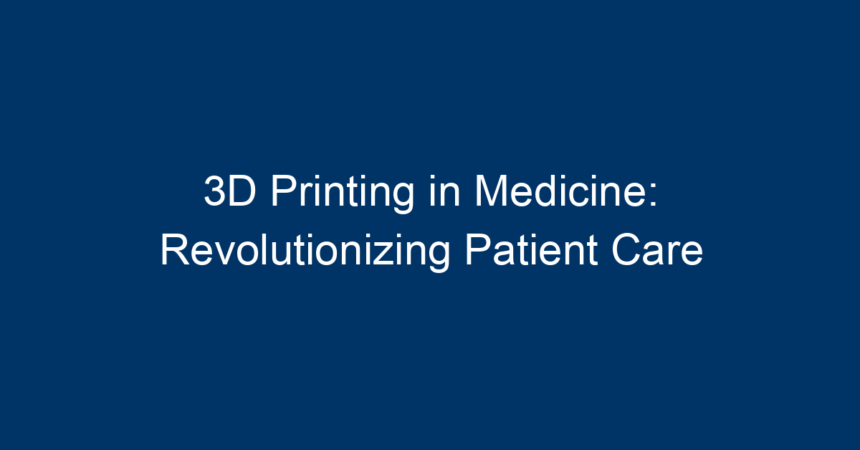The field of medicine is undergoing a remarkable transformation, driven by technological advancements that enhance patient care and treatment outcomes. Among these innovations, 3D printing in medicine stands out as a game-changer. From creating customized prosthetics to bioprinting tissue, this revolutionary technology is reshaping how healthcare professionals approach diagnosis, treatment, and rehabilitation. But what exactly does this mean for patients? Let’s explore the vast landscape of 3D printing in medicine and its profound impact on patient care.
What is 3D Printing?
3D printing, also known as additive manufacturing, is a process that creates three-dimensional objects from a digital file. By layering materials, often plastics, metals, or biological substances, this innovative technology allows for the production of complex structures with high precision. The medical field has quickly adopted 3D printing, leading to significant breakthroughs that enhance patient outcomes.
The Role of 3D Printing in Patient-Centric Care
Customized Implants and Prosthetics
One of the most significant applications of 3D printing in medicine is the creation of customized implants and prosthetics. Traditional implants often require significant adjustments during surgery, leading to longer recovery times and potential complications. With 3D printing, however, healthcare providers can create patient-specific implants that fit perfectly to the individual’s anatomy.
- Benefits of Customization:
- Improved Fit: Customized implants reduce the risk of complications and discomfort.
- Reduced Surgery Time: Surgeons can operate more efficiently, leading to shorter hospital stays.
- Enhanced Patient Satisfaction: Patients experience better outcomes and improved quality of life.
Surgical Planning and Simulation
3D printing enables surgeons to create physical models of patients’ anatomy, allowing for thorough preoperative planning. These models can be produced from CT or MRI scans, providing a tangible reference that enhances surgical precision.
- Advantages of Surgical Simulation:
- Reduced Surgical Risks: Surgeons can anticipate potential challenges before entering the operating room.
- Enhanced Communication: Patients and their families can better understand the procedure through visual aids, fostering trust and reducing anxiety.
Bioprinting: The Future of Organ Transplants
The demand for organ transplants far exceeds the available supply, leading to long waiting lists and countless unmet medical needs. Bioprinting, a subset of 3D printing, involves layering living cells, biomaterials, and growth factors to create tissues and organs.
Progress in Bioprinting Technology
Researchers are making significant strides in bioprinting capabilities. For instance, they have successfully printed grafts for skin and cartilage, showing promising results in preclinical trials.
- Potential Benefits of Bioprinting:
- Reduced Rejection Rates: Organs printed using a patient’s own cells reduce the risk of organ rejection.
- Sustainable Solutions: Bioprinted organs could alleviate the donor shortage crisis.
Challenges Ahead
Despite these advancements, bioprinting remains in its infancy, facing challenges such as tissue vascularization and complex organ structure development. However, ongoing research and investment are expected to expedite progress in this field.
Educational and Training Applications
The integration of 3D printing in medicine extends beyond patient care; it also serves as a powerful educational tool. Medical schools and training centers are now leveraging 3D-printed anatomical models to enhance learning experiences.
Enhanced Learning and Training
- Interactive Experience: Students can interact with realistic 3D models, gaining a deeper understanding of human anatomy and surgical techniques.
- Safe Practice Environment: Trainees can practice procedures on 3D-printed replicas, refining their skills without putting patients at risk.
Market Trends and Future Prospects
The market for 3D printing in medicine is expanding rapidly. According to recent studies, the global 3D printing healthcare market is expected to reach $6.5 billion by 2025, driven by increasing demand for customized solutions and technological advancements.
Areas of Growth
- On-Demand Production: As the technology matures, healthcare providers can manufacture medical devices and solutions on-demand, minimizing inventory costs.
- Telemedicine Integration: Alongside telehealth solutions, 3D printing can enhance remote consultations by enabling personalized care from afar.
Challenges and Considerations
Despite its promise, 3D printing in medicine faces challenges that need to be addressed for widespread adoption.
Regulatory Hurdles
The regulatory environment surrounding 3D printing technologies can be complex, with concerns about safety, efficacy, and quality control. Regulatory bodies like the FDA are working to establish guidelines specific to 3D-printed medical devices.
Cost Implications
While 3D printing can lower costs in the long run, initial setup and material expenses can be significant. Healthcare organizations must weigh these costs against potential savings in patient care.
Concluding Insights: Embracing the Change
As the field of medicine continues to evolve, 3D printing in medicine stands at the forefront of transformation. Its impact on patient care, from customized implants to surgical training, is helping to build a future where medical solutions are more precise and personalized.
Actionable Insights for Healthcare Providers
- Invest in Training: Encourage staff to engage in workshops and training sessions focused on 3D printing technologies.
- Collaborate with Experts: Partner with tech companies and academic institutions to stay updated on the latest advancements in 3D printing.
- Promote Patient Education: Use 3D-printed models to educate patients about their treatment options, fostering trust and involvement in their care.
By embracing the potential of 3D printing, healthcare providers can pave the way for innovative patient solutions that improve outcomes and enhance the overall healthcare experience.
In conclusion, 3D printing in medicine is not just a trend; it’s a revolutionary tool that holds the promise of a healthier future, where patient care is more personalized and effective than ever before.




